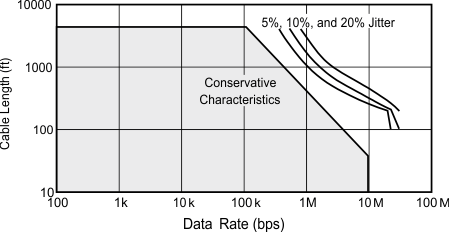SLLSFP5A January 2024 – August 2024 THVD2419 , THVD2429
PRODUCTION DATA
- 1
- 1 Features
- 2 Applications
- 3 Description
- 4 Device Comparison Table
- 5 Pin Configuration and Functions
- 6 Specifications
- 7 Parameter Measurement Information
- 8 Detailed Description
- 9 Application and Implementation
- 10Device and Documentation Support
- 11Revision History
- 12Mechanical, Packaging, and Orderable Information
9.2.1.1 Data Rate and Bus Length
There is an inverse relationship between data rate and cable length, which means the higher the data rate, the short the cable length; and conversely, the lower the data rate, the longer the cable length. While most RS-485 systems use data rates between 10kbps and 100kbps, some applications require data rates up to 250kbps at distances of 4000 feet and longer. Longer distances are possible by allowing for small signal jitter of up to 5 or 10%.
 Figure 9-2 Cable Length vs Data Rate Characteristic
Figure 9-2 Cable Length vs Data Rate CharacteristicEven higher data rates are achievable (that is, 20Mbps for the THVD2429) in cases where the interconnect is short enough (or has suitably low attenuation at signal frequencies) to not degrade the data.